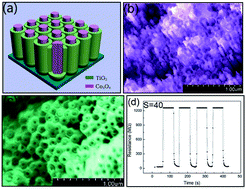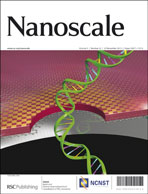Design of a highly sensitive ethanol sensor using a nano-coaxial p-Co3O4/n-TiO2 heterojunction synthesized at low temperature†
Abstract
In this paper, we describe the design, fabrication and gas-sensing tests of nano-coaxial p-Co3O4/n-TiO2 heterojunction. Specifically, uniform TiO2 nanotubular arrays have been assembled by anodization and used as templates for generation of the Co3O4 one-dimensional nanorods. The structure morphology and composition of as-prepared products have been characterized by SEM, XRD, TEM, and XPS. A possible growth mechanism governing the formation of such nano-coaxial heterojunctions is proposed. The TiO2 nanotube sensor shows a normal n-type response to reducing ethanol gas, whereas TiO2–Co3O4 exhibits p-type response with excellent sensing performances. This conversion of sensing behavior can be explained by the formation of p–n heterojunction structures. A possible sensing mechanism is also illustrated, which can provide theoretical guidance for the further development of advanced gas-sensitive materials with p–n heterojunction.


 Please wait while we load your content...
Please wait while we load your content...